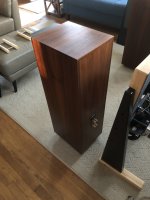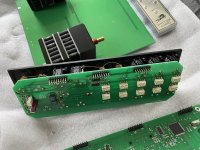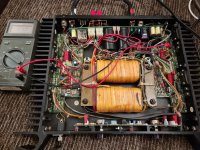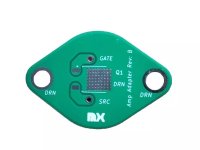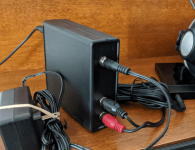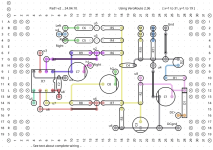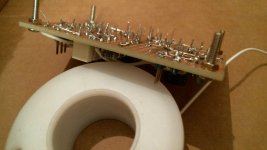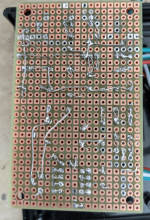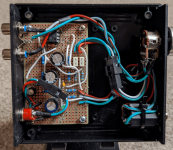A very special thank you to Papa, Zen Mod, & ItsAllInMyHead!
Your generosity is a blessing, a gift, an inspiration.
[As of 3/20/24, this post is still a draft in work. I'll update this first post with additional "lessons learned" over the course of a few days. -birdbox]
Somehow I found myself to be blessed to reach out to the right person at the right time (just after Christmas) and was given the gift to be an early builder of the Firstwatt Aleph J, Zen Mod edition.
@ItsAllInMyHead was looking for some lucky folks to build the kits he’s working on for the store. I think his goal was to get a couple folks to verify the kits are complete, provide feedback on the to be released build guide, and share lessons learned along the way.
After eagerly accepting Patrick’s offer, I soon had the kit in hand and began the process of “asking Patrick a thousand questions”. Man is this guy patient and kind! I wanted to build it as fast possible, however, I learned along the way that “slow is smooth, and smooth is fast”. The build guide is top notch and certainly is on par with the quality build guides 6L6 provides the diyaudio community. This is going to be a fantastic kit for “new-ish” folks like myself, who have built some store kits in the past with SMPS power supplies, and are now interested into wandering into the Firstwatt amp designs with linear power supplies.
Up until this point I had built a pair of mono Amp Camp Amp’s, a couple Korg B1s, an Amp Camp Preamp+, WHAMMY, ACA-Mini, and the Zenductor (at BAF ’23). So although I wasn’t a tadpole anymore, I was still pretty much a minnow in a giant ocean. It was attending BAF in October of 2023 that had me catch whatever "bug" it is we call diyaudio. Before that event I was diyaudio-curious, afterwards, I was diyaudio-obsessed. Antibiotics did nothing, antivirals did nothing, the only cure was more amps! So I started to research and read regularly about what are some next options I could jump on. Iron Pre sounded like a fun project, but the store was sold out. My thinking was F5 would be a good first build, then I bumped into ItsAllInMyHead via a post and PM, and the rest was fate.
Ok, enough backstory, that’s not all that interesting really. Let’s talk this wonderful amp kit...
The boards are very well laid out, great fabrication with lots of shinny gold, and compact. They fit the universal mounting system (UMS), so I went with the chassis I had on hand from Modushop’s Black Friday sale, a 4U Deluxe. The kit provided had all the parts necessary to stuff the boards. I had already started to acquire some basic parts I knew I would need regardless of what Firstwatt design I’d try and build, so I had an Antek AS-3218 on hand as well as a AS-4220.
I also needed:
- PSU Filter Board V3 from the store
- Rectifiers – Monolithic using rhthatchers boards
- CL60 Inrush limiter – using rhthatcher boards
- Wiring
- For AC & DC power & speaker out I used 16Ga – BNTECHGO Silicone Kits on Amazon
- For signal I used Mogami W2330 from Markertek
- Back connectors (Neutrik RCA & Speaker Terminals) – Back Parts Kit from store
- Keratherm Insulator Pads – diyaudio store
- Heat shrink – Amazon cheap variety kit
- Crimpers – Haisstronica Crimping Kit on Amazon
- Faston spade connectors (sorry ZM) – Mouser/Digikey
- Power Entry Module – Back Parts Kit from store
- M3 bolts - variety kit from Amazon
- Standoffs - nylon spacers & brass hex variety kits from Amazon
- ??
I did my very best to practice patience and go slow to ensure I did it right the first time. That wasn't easy, but I kept telling myself "Follow the process". I followed the build guide and asked Patrick lots of questions allong the way that he graciously answered with enthusiasm.
So, enough with all the words….time for some pics.
Here's
@rhthatcher 's insrush and rectifier boards all populated with components.
All the parts in the kit (I wasn't supposed to open it all at once, so don't do what I did)
Crossing off components as they are installed on the schematic.
Crossing off components as they are installed on the PCB layout.
I loved the "verify" / "install" / "inspected" approach. This sets the stage for a really good quality process.
Patrick shared the value and "tricks" he had for cleaning the board (99% Isop, Acid Brush, Kimwipes). I went one step further and got a cheap sonic toothbrush.
I cleaned up the top and bottome with 99% Isop and sonic toothbrush. I would "rinse" the board with Isop after a scrub, then repeated 2 more times. 3rd Times a Charm.
Oooooo, shiny!
Extra large fender washer (1/8" ID x 3/4" OD), lock washer, and M3 boltholds MOSFET on Keratherm pad.
Finished board mounted and torqued to 0.9 N-m.
Laying out the linear power supply components.
Twisted all the wires and mounted the AS-3218 on a fancy little seat so I could use "lip up" on chassis plate and still have transformer really close to front panel.
For space reasons, I used the Modushop "riser" to go vertical with the PSU filter board.
Power supply checkout. Don't forget to wait plenty of time for caps to discharge. I would measure voltage with multimeter to be sure they were discharged.
Don't forget the chassis thermister. I did at first. I slide it into the soft silicone insulation and use a little solder to secure it in place.
@rhthatcher rectifier boards with snubber resistors & capacitors per Quasimodo link suggestions. You'll notice the R values are different here than the picture above. Well, I ran into a really bad transformer hum issue. I tried every possible solution. It took me 3 days to figure it out. In the end, the problem was my recessed LED dimmable lights on a triac autodimmer. If the lights were set at 40-60%, transformer hummed crazy loud. Any other setting on the dimmer, dead silent. [Insert "The Far Side - We should write that down somewhere" comic.]
Setting the bias connections using the little "grabbers".
Bias setting heat soak. [0.46V across 0.27ohm yeilds a bias of 1.7amps]
Trying to clean up the wiring with zipties after getting the DC offset down to pretty much 0.0V
So how does it sound? I’m not very good at describing the “sound” of an amp with eloquent descriptions, personifications, and analogies, so I’ll just quote what I told Patrick after spending a few hours listening to it….
“WOW, just WOW”
By far the best sounding amplifier I own and punches well above anything I could have expected. This amp is not just a winner, it dominates. I love it. I’ll probably name it and keep it close to me for the rest of my life as my “first Firstwatt". What a wonderful experience.
Thank you Papa!
Thank you Zen Mod!!
Thank you so much Patrick!!!
Now, what's next?





